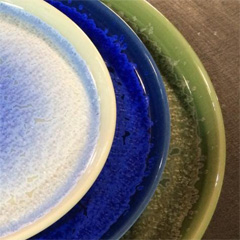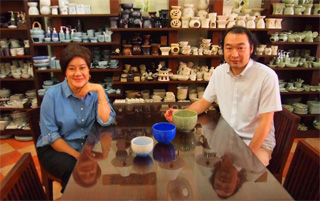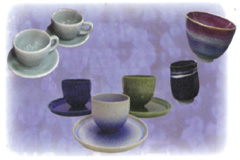Reports and Statistics
Survey Reports
June 2014
Challenge! International Business - Fusing tradition of Japan and Thai: Shinemon Inc.
The fusion of two traditions to blaze a trail - The Japanese Arita Ware and Thai Celadon Ware have been combined to create a new brand Sara. Abundantly endowed with the Arita techniques, the new brand was born as lightweight tableware with delicate designs and colorful expression in Chiang Mai.
Building on the concept of "bringing high-quality tableware into daily life", the enthusiasm on the part of traditional craftsmen for making a change, developing a good relationship of trust between both sides and the craftsmen's experiences were brought together to complete the new brand. It is a challenge for a traditional craft, facing a crossroad due to the shrinking domestic market, to find a new market.

New brand Sara series
Pouring the Arita techniques into Chiang Mai
Chiang Mai is Thailand's second largest city, located in the northern part of Thailand with a population of approximately 300 thousand people, where balmy tropical breezes flow through. The celadon is famous as a traditional industry which originated in China and spread to other regions in Asia from the 10th century.
KASAMA, a trade company from Thailand dealing with sundry goods opened its porcelain kiln here in 1995. KASAMA sounds like a Japanese name, but actually it's a Thai name: the name of the representative director's grandfather.
In September 2013, KASAMA joined hands with Shinemon Kiln, which makes Arita Ware, and launched the new brand. The name Sara means "a craftsman with expert craftsmanship" in the local language. This tableware series is lavished with the techniques developed in Arita. From plaster that is used for raw materials and molds to all the processes of making Celadon ware, including cutting and polishing, were revised. The original thick and strong ware was transformed into tableware with light and delicate impressions. The in-kiln mutation called yohen, which is a color expression the Shinemon Kiln is good at is also something to see. From the pale emerald green and the shades of transparent blue in the back, a peculiar pattern emerges. Tableware with elegance and mystery decorates the table. This pattern is a by-product of a chemical reaction in the glazes which is born from combined factors that include the types of soil, burning conditions and weather conditions, not to mention the glazing combination. In the future, they plan to sell products targeted at the large market of customers in their twenties and thirties in ASEAN countries. The new product has got off to a good start with a purchase of all products in stock by one of KASAMA's valued clients.
Traditional industry subjected to changes
Arita Ware will soon mark the 400th anniversary of its foundation since Sanpei Lee, the
ancestral father of Arita porcelain, opened the first kiln in 1616. Despite its established reputation, like many other traditional crafts, domestic sales have been stagnant. The total revenue of the industry, which reached 25 billion yen during the bubble economy dropped to 5 billion yen in 2012. Shinemon Kiln started to explore the Chinese market in search of new opportunities. Since then, it has succeeded in delivering products to major department stores with their sales accounting for one-quarter of total sales. However, after going through the temporary sharp decline in sales due to the boycott of Japanese products, it has been searching for other markets, so as not to depend too much on exports to China.

At Chiang Mai, Representative Director Arpasra Kleine of KASAMA (picture on the left) and Mr. Kusuo Baba (picture on the right)
Preserving the hand-made process
Meanwhile, KASAMA's products have been subject to intense price competition with cheap Chinese factory products. Despite active participation in the government-led technical training, there was no breakthrough solution to the situation. Sales were reduced to one-third of those of five years earlier. Then came the turning point in September 2012. Mr. Hisakazu Baba of Shinemon, who was a manager of the overseas business, encountered KASAMA's products introduced at a JETRO seminar. Immediately, he saw great possibilities in them and flew to Thailand the following month. In December, he invited the representative director and the factory manager of KASAMA to Japan and introduced them to the techniques of Arita Ware, and in April 2013, Shinemon entered into a technical alliance and license agreement with the Thai company. Using the Experts Dispatch Program by the Overseas Human Resources and Industry Development Association (HIDA), Shinemon started to provide on-site technical training to local staff and went ahead with the launch of the new brand, while KASAMA obtained distribution rights of the Sara brand given the company's business negotiation skills with overseas corporations. Shinemon decided to focus on improving the manufacturing techniques. It was a business model making use of both sides' areas of specialty.
It's Mr. Baba's earnest desire to develop ceramics for the public, that is to say, to develop not only gift items and furnishing goods but also good-quality tableware for daily use that appeal to general consumers. He thought that the low-priced (nearly one-quarter of the Arita ware), high-quality (with well-known Arita techniques) Sara series would sell very well in such places as shopping malls filled with young people and select shops lined with stylish general goods. It was a clever move to collaborate with the Thai company for opening up the traditional industry market.
World-class products made in Thailand
In the course of developing the Sara series, Mr. Baba stuck to local procurement of raw materials for ceramic clay and glazes and processing utensils in Thailand. In Arita, he has everything he needs, but that was not the case with Chiang Mai. He repeatedly visited parts manufacturers throughout the country to engage in negotiations with them. In order to reproduce the Arita quality, it was essential to make a precise analysis of the local natural
materials; however, it was difficult to obtain accurate data from the laid-back Thai people. Why did he work so hard? He did so not only for the sake of cost reductions by procuring materials locally, but also believed that if the Sara series became recognized as brand from Thailand, the Thai Celadon would attract more attention globally.
When Mr. Baba presented this project to one of his valued Chinese customers, he scoffed at the idea, saying, "What the Chinese want is ceramics made in Japan, not from Thailand".
Mr. Baba is confident about changing this perception because he established a trustful relationship with KASAMA. In Chang Mai, there are situations in which the common sense he has used to date in Japan does not apply. Whether or not the finished products are good is solely based on the workmanship of the craftsmen in each process. In order to allow the craftsmanship spirit of Japan (monozukuri) to take root in the worksite where craftsmen get ready to go home before the end of the day, it was necessary to share confidence with them. In the beginning, the Thai food did not suit him, but he made an effort to sit at the table with the craftsmen. A month after he came to Chiang Mai, he was able to have a serious discussion with the local craftsmen about issues including measures to prevent recurrence of defective products and the production methods that consider the next process. It was only then that he realized that the management of the worksite was getting on the right track. Mr. Baba felt a good response, saying, "Every time they removed pots from the kiln, the finished products were more expressive". Although the technical alliance carries a risk of information leaks, he places his confidence in local craftsmen who never lie. He had to go through a great deal of trouble to get his business on track, but the mild climate in Chiang Mai may have soothed his heart. Despite hardships, the business collaboration with KASAMA has brought more benefits than harm to Shinemon Kiln.

Fusion of Celadon ware (upper left) and Arita Ware (upper right) to create Sara (picture in the middle)
Mr. Kusuo Baba, the second CEO of Shinemon Inc. says, "What we need to produce, the techniques and the means involved in the production change with the times. Tradition means continuing to pursue Arita's craftsmanship responding to changing conditions." What kind of new value will be provided by the collaboration with the overseas company? It is quite exciting to visualize the future shaped by Shinemon and KASAMA.
Naoki Tanabe
JETRO Saga
Shinemon Inc.
CEO: Kusuo Baba
Foundation: 1972
Location: 200 Nanbaru-kou, Arita-cho Nishi matsuura-gun, Saga
Business description: ceramics manufacturing
Webpage: http://www.sinemon.com/
KASAMA Pottery Co., Ltd.
Representative Director: Arpasra Kleine
Foundation: 1995
Location: Sansai Chiangmai
Business description: ceramics manufacturing
Webpage: http://www.kasama-kasama.com/



